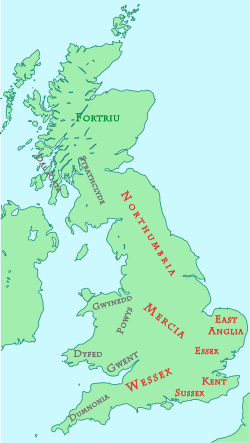Kingdom of Sussex
| Sussex | ||||||||||||
| Sūþseaxna rīce | ||||||||||||
| Vassal of Wessex (686–726, 827–860) Vassal of Mercia (771–796) |
||||||||||||
|
||||||||||||
|
Britain around AD 800
|
||||||||||||
| Capital |
Chichester Selsey (seat of South Saxon bishopric) |
|||||||||||
| Languages | Old English (Ænglisc) | |||||||||||
| Religion |
Paganism (before 7th century) Christianity - Pre-Schism (after 7th century) |
|||||||||||
| Government | Monarchy | |||||||||||
| Monarchs (see full list) | ||||||||||||
| • | 477–491 or later | Ælle | ||||||||||
| • | fl. c. 660 – c. 685 | Æðelwealh | ||||||||||
| Legislature | Witenagemot | |||||||||||
| Historical era | Heptarchy | |||||||||||
| • | Established | c. 477 | ||||||||||
| • | Subject to Wessex | c. 686 to 726 | ||||||||||
| • | Subject to Mercia | 771 to c. 796 | ||||||||||
| • | Subject to Wessex | From c. 827 | ||||||||||
| • | Full integration into crown of Wessex | 860 | ||||||||||
| Population | ||||||||||||
| • | 450 est. | 25,000 | ||||||||||
| • | 1100 est. | 35,000 | ||||||||||
| Currency | Sceat | |||||||||||
|
||||||||||||
| Today part of |
∟ South East England |
|||||||||||
Sussex (/ˈsʌsɪks/; Old English: Sūþseaxna rīce, "kingdom of the South Saxons") was a Saxon colony and later independent kingdom of the Saxons, on the south coast of England.
The South Saxons were ruled by the kings of Sussex.
The Kingdom of Sussex had its initial focus in a territory based on the former kingdom and Romano-British civitas of the Regnenses and its boundaries coincided in general with those of the later county of Sussex. For a brief period in the 7th century, the Kingdom of Sussex controlled the Isle of Wight and the territory of the Meonwara in the Meon Valley in east Hampshire. From the late 8th century, Sussex seems to have absorbed the Kingdom of the Haestingas, after the region was conquered by the Mercian king Offa.
A large part of its territory was covered by the forest that took its name from the fort of Anderitum at modern Pevensey, it was known to the Romano-British as Forest of Andred and to the Saxons as Andredsleah or Andredsweald, known today as the Weald. This forest according to the Anglo-Saxon Chronicle was 120 miles (190 km) wide and 30 miles (50 km) deep (although probably closer to 90 miles (140 km) wide). It was the largest remaining area of woodland and heath in the territories that became England and was inhabited by wolves, boars and possibly even bears. It was so dense that even the Domesday Book did not record some of its settlements. The heavily forested Weald made expansion difficult but also provided some protection from invasion by neighbouring kingdoms. Whilst Sussex's isolation from the rest of Anglo-Saxon England has been emphasised, Roman roads must have remained important communication arteries across the forest of the Weald. The Weald was not the only area of Sussex that was forested in Saxon times, for example at the western end of Sussex is the Manhood Peninsula, which in the modern era is largely deforested, however the name is probably derived from the Old English maene-wudu meaning "men's wood" or "common wood" indicating that it was once woodland.
...
Wikipedia

